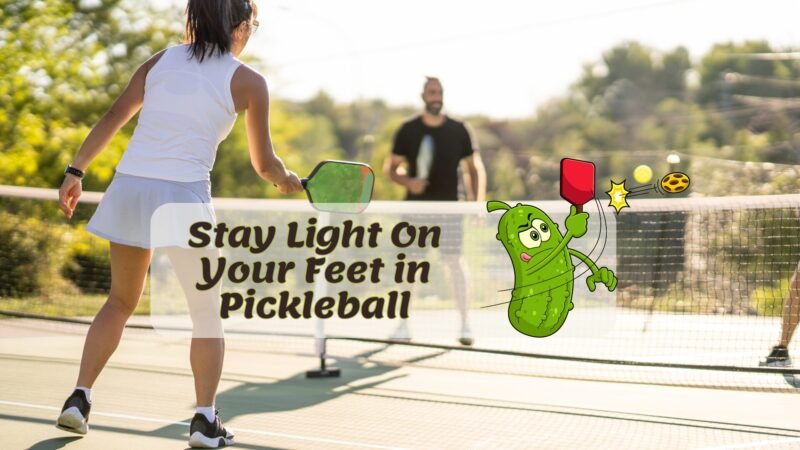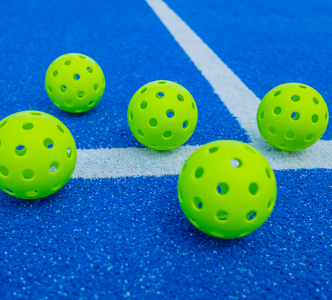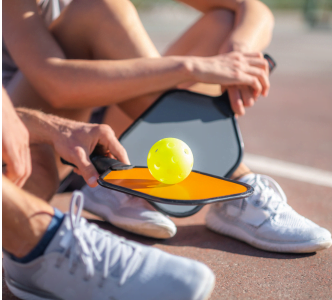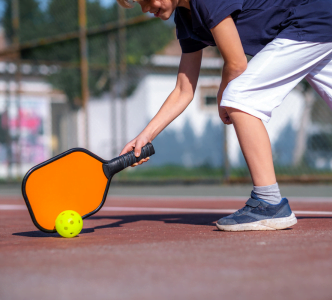Pickleball is everywhere, and everyone loves it because it’s fun and fast. To be good you need to move quickly and stay light on your feet in pickleball. Think of it like dancing across the court, where being quick on your feet makes a big difference. Let’s explore how you can stay light on your feet and make your pickleball game even better.
The Foundation of Agility in Pickleball
Ever wonder what it means to be “Stay light on your feet in pickleball”? It’s the important skill that separates the good players from the great ones. Being light on your feet during a pickleball game is all about agility, balance, and stability. It’s the ability to move quickly and effortlessly in any direction, responding to the game’s fast pace with grace and precision.
Agility is your best friend on the court especially when playing against a tall pickleball player, It allows you to switch directions at a moment’s notice. It’s not just about speed, it’s about how swiftly you can stop, start, and change course without losing your footing.
Balance plays a crucial role here, ensuring you remain upright and ready, no matter how intense the game gets. And then there’s stability, the foundation that keeps everything else in check. It’s what prevents those unwanted stumbles and keeps your movements smooth and controlled.
Essential Footwork Drills for Pickleball Players
First up, is the split step. This little move is your best friend when it comes to staying ready. Right as your opponent hits the ball, do a small hop. This hop gets you ready to move in any direction. Think of it as hitting the reset button for your feet, keeping you on your toes and ready to spring into action.
Next, we’ve got ladder drills. If you’ve ever seen those flat ladders on the ground, that’s what we’re talking about. These drills are all about improving your foot speed and coordination.
Quick in, quick out, moving side to side, and forward and back. It’s like playing hopscotch on turbo mode. You’ll be amazed at how it helps your game.
Don’t forget about the side shuffle and zig-zag drill. These are your go-to’s for getting better at moving side to side and forward. The side shuffle gets you moving quickly across the court without losing your balance.
The zig-zag drill? It’s all about changing directions fast. Start at one corner of the court, sprint forward then cut to the side, and repeat. It’s like you’re dodging obstacles, making you nimble and quick.
Building Lower Body Strength for Better Movement
Squats are your first stop. They’re like the Swiss Army knife of exercises, working almost every muscle in your lower body. Plus, they mimic the action of getting ready for a shot in pickleball, building strength and endurance where it counts. Start simple, and as you get stronger, you can add weights to keep challenging yourself.
Then, there are lunges. Step forward, lower down, and push back up. Lunges are great for targeting each leg individually, which helps even out any imbalances. They give your thighs and glutes a serious workout, making you more stable on the court.
Don’t overlook calf raises. They might seem small, but calves play a big role in how fast you can move. Strong calves mean more power when pushing off to reach a far-off shot. You can do these anywhere, anytime. Just lift those heels, hold, and lower back down.
Why does all this matter? Well, stronger legs mean you’re less likely to commit foot faults. You’ll have better control over your movements, especially near the tricky kitchen line. Plus, with more power in each step, you’ll cover the court more efficiently, keeping you in the game longer without tiring out.
Nutrition and Hydration for Staying light on your feet in Pickleball
Starting with nutrition, think of your food as your fuel. Nutrient-dense foods pack a big punch, giving you the energy you need to keep moving. We’re talking fruits, veggies, lean proteins, and whole grains. These foods keep your energy levels steady, so you can dash, dive, and dominate all day long.
But let’s not forget about hydration. Water is key to staying light on your feet. It keeps your joints lubricated, and muscles working smoothly and helps you think clearly. Ever feel sluggish or slow on the court? You might just need a water break. Aim to drink plenty of fluids before, during, and after play. It’s a simple step, but it makes a big difference in your agility and quickness.\
Mental and Visual Preparation for Quick Reflexes
Visualization is a powerful tool. Imagine yourself on the court, moving effortlessly, reaching every shot with time to spare. Picture your success in vivid detail – the perfect serve, the unbeatable volley.
This mental rehearsal primes your brain, making those imagined scenarios more likely to play out in real life. It’s like a practice session in your mind, where every shot lands just right.
But it’s not just about seeing; it’s about anticipating. Mental preparation helps you predict your opponent’s next move, giving you those extra precious moments to react.
Think of it as a chess game, where you’re always two steps ahead. By staying mentally sharp, you can read the game better, move faster, and keep your feet moving light and quick.
Warm-Up and Cool-Down: Essential Practices for Agility
Kicking things off with a proper warm-up sets the stage for your best performance. Dynamic stretches get your muscles ready for action, not just limber, but also primed and pumped.
Think leg swings, arm circles, and gentle lunges. Then, add some light cardio – a brisk walk or a few minutes of jumping jacks. This combo wakes up your body, telling every part it’s showtime.
Now, after you’ve given your all on the court, don’t just call it a day. Cooling down is your body’s time to catch its breath and start the recovery process.
Gentle stretches help ease your muscles back into normalcy, preventing stiffness and soreness. It’s like giving your body a thank-you note for all the hard work, ensuring it’s ready to go again next time.
Ever played against an aggressive pickleball player? if yes read out our comprehensive and practical strategies about, how to beat aggressive pickleball players.
Mastering the Art of the Volley and Foot Faults
First off, volleying is all about timing and position. To volley like a pro, you need to hit the ball before it bounces, but there’s a catch – the non-volley zone, also known as the kitchen.
Stepping into this zone on a volley is a big no-no. Practice your reach and balance. Work on stretching towards the ball without letting your momentum carry your feet forward into the kitchen.
Understanding the kitchen line rules is crucial. Your feet must not touch the line or the zone itself when you volley. It’s all about control and precision.
Think of it as a dance where your feet know exactly where to land. This not only keeps you from committing foot faults but also positions you better for your next move.
Avoiding foot faults also means being mindful of where you serve from. Always serve behind the baseline, giving yourself plenty of room. It’s easy to step forward out of habit, so focus on planting your feet firmly before you serve.
Advanced Movement Strategies: From Dinking to Dominating
Dinking, the gentle, strategic placement of the ball into the non-volley zone, is a skill that can frustrate opponents and create openings for winning shots. Practice dinking drills to get the ball just over the net with a soft touch. It’s about precision, not power.
Aim for consistency in your dinks, making them land close to the net every time. This forces your opponent to move forward, opening up the court for you to exploit.
But dinking is just one piece of the puzzle. Your movement and positioning on the court are what allow you to control the game. Always aim to be in the “ready position” – feet shoulder-width apart, knees slightly bent, paddle up.
From here, you can move quickly in any direction. Work on drills that improve your lateral movement and your ability to quickly come forward for a dink or move back for a lob.
Covering the court effectively means anticipating your opponent’s next move. Pay attention to their body language and paddle position; these clues can tell you where the ball is likely going. The better you get at reading the game, the better you’ll be at positioning yourself to take control of the rally.
Equipment and Gear for Enhanced Performance
When it comes to pickleball, your gear can be a game-changer. Let’s talk about the foundation of all your swift moves: your footwear. The right shoes do more than just protect your feet; they’re your secret weapon for staying light on your feet.
They provide the grip you need to pivot, dash, and stop on a dime. But it’s not just about the shoes. Have you heard of CURREX PICKLEBALLPRO insoles? These insoles are designed specifically for pickleball players, offering unmatched support and cushioning.
They adapt to your foot’s shape, ensuring every movement is supported, from the quick lateral moves to those sudden sprints to the net.
Learning from the Pros: Insights and Strategies
Ever notice how the pros seem to glide across the court with effortless grace? It’s all in their footwork. Analyzing the movements of professional pickleball players reveals a ballet of precision, where every step is calculated and every movement is optimized for both speed and stability.
But how do they maintain such lightness on their feet during the heat of intense matches? The secret lies in muscle memory.
Through countless hours of practice, pros develop an intuitive understanding of the court, allowing them to anticipate shots and position themselves optimally with minimal conscious thought. This isn’t just about physical agility; it’s about training the brain to read the game, making quick, efficient movements second nature.
By studying these athletes, we can learn the importance of deliberate practice. Focusing on drills that enhance agility, balance, and quickness, and incorporating these elements into our game, can elevate our play.
Conclusion
staying light on your feet in pickleball is a blend of practice, the right gear, and learning from those who’ve mastered the game. From footwork drills that build agility to choosing equipment that supports your movement, every step you take towards improving your game counts. Watching the pros and understanding the importance of muscle memory can also provide invaluable insights.
FAQ’s
How often should I practice footwork drills for optimal agility in pickleball?
Practicing footwork drills 2-3 times a week can significantly improve your agility on the pickleball court. Consistency is key, as regular practice helps build muscle memory and enhances your ability to move quickly and efficiently during a game. Incorporating variety in your drills can also prevent boredom and ensure a well-rounded agility training routine.
Can specific shoes improve my performance in pickleball?
Yes, wearing shoes designed for pickleball or similar court sports can improve your performance. These shoes offer better grip, support, and stability, which are crucial for quick lateral movements and reducing the risk of slips and falls. Look for shoes with good cushioning and lateral support to keep your feet comfortable and agile on the court.
What are the best foods to eat before a pickleball game for energy?
Eating a balanced meal with complex carbohydrates, lean protein, and healthy fats about 2-3 hours before playing pickleball can provide sustained energy. Foods like whole-grain pasta, chicken breast, mixed vegetables, and a small serving of avocado are ideal. A banana or a small energy bar 30 minutes before the game can also give you a quick energy boost.
How does mental preparation impact my pickleball game?
Mental preparation can significantly impact your pickleball game by improving focus, reducing anxiety, and enhancing decision-making speed. Techniques like visualization and positive self-talk can help you anticipate opponents’ moves more accurately and maintain confidence throughout the game. This mental readiness translates to quicker reactions and more strategic play on the court.
Is it necessary to cool down after playing pickleball?
Cooling down after playing pickleball is essential for preventing muscle soreness and promoting recovery. Gentle stretching and a slow walk for 5-10 minutes help to gradually lower your heart rate and relax your muscles. This practice reduces the risk of injury and helps your body recover more efficiently, keeping you ready for your next game.







